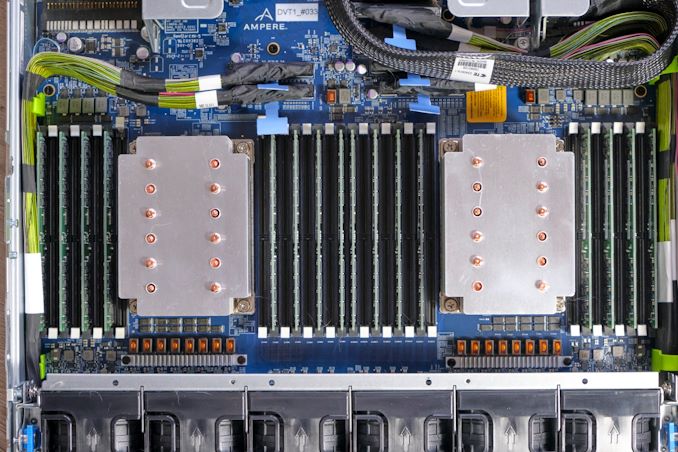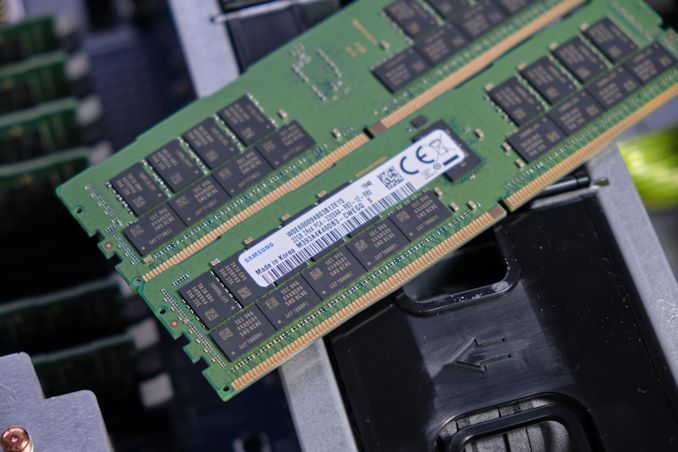The Ampere Altra Review: 2x 80 Cores Arm Server Performance Monster
by Andrei Frumusanu on December 18, 2020 6:00 AM EST- Posted in
- Servers
- Neoverse N1
- Ampere
- Altra
Test Bed and Setup - Compiler Options
For the rest of our performance testing, we’re disclosing the details of the various test setups:
Ampere "Mount Jade" - Dual Altra Q80-33
Obviously, for the Ampere Altra system we’re using the provided Mount Jade server as configured by Ampere.
The system features 2 Altra Q80-33 processors within the Mount Jade DVT motherboard from Ampere.
In terms of memory, we’re using the bundled 16 DIMMs of 32GB of Samsung DDR4-3200 for a total of 512GB, 256GB per socket.
| CPU | 2x Ampere Altra Q80-33 (3.3 GHz, 80c, 32 MB L3, 250W) |
| RAM | 512 GB (16x32 GB) Samsung DDR4-3200 |
| Internal Disks | Samsung MZ-QLB960NE 960GB Samsung MZ-1LB960NE 960GB |
| Motherboard | Mount Jade DVT Reference Motherboard |
| PSU | 2000W (94%) |
The system came preinstalled with CentOS 8 and we continued usage of that OS. It’s to be noted that the server is naturally Arm SBSA compatible and thus you can run any kind of Linux distribution on it.
Ampere makes special note of Oracle’s active support of their variant of Oracle Linux for Altra, which makes sense given that Oracle a few months ago announced adoption of Altra systems for their own cloud-based offerings.
The only other note to make of the system is that the OS is running with 64KB pages rather than the usual 4KB pages – this either can be seen as a testing discrepancy or an advantage on the part of the Arm system given that the next page size step for x86 systems is 2MB – which isn’t feasible for general use-case testing and something deployments would have to decide to explicitly enable.
The system has all relevant security mitigations activated, including SSBS (Speculative Store Bypass Safe) against Spectre variants.
AMD - Dual EPYC 7742
For our AMD system, unfortunately we had hit some issues with our Daytona reference server motherboard, and moved over to a test-bench setup on a SuperMicro H11DSI0.
We’re also equipping the system with 256GB per socket of 8-channel/DIMM DDR4-3200 memory, matching the Altra system.
| CPU | 2x AMD EPYC 7742 (2.25-3.4 GHz, 64c, 256 MB L3, 225W) |
| RAM | 512 GB (16x32 GB) Micron DDR4-3200 |
| Internal Disks | OCZ Vector 512GB |
| Motherboard | SuperMicro H11DSI0 |
| PSU | EVGA 1600 T2 (1600W) |
As an operating system we’re using Ubuntu 20.10 with no further optimisations. In terms of BIOS settings we’re using complete defaults, including retaining the default 225W TDP of the EPYC 7742’s, as well as leaving further CPU configurables to auto, except of NPS settings where it’s we explicitly state the configuration in the results.
The system has all relevant security mitigations activated against speculative store bypass and Spectre variants.
Intel - Dual Xeon Platinum 8280
For the Intel system we’re also using a test-bench setup with the same SSD and OS image actually – we didn’t have enough RAM to run both systems concurrently.
Because the Xeons only have 6-channel memory, their maximum capacity is limited to 384GB of the same Micron memory, running at a default 2933MHz to remain in-spec with the processor’s capabilities.
| CPU | 2x Intel Xeon Platinum 8280 (2.7-4.0 GHz, 28c, 38.5MB L3, 205W) |
| RAM | 384 GB (12x32 GB) Micron DDR4-3200 (Running at 2933MHz) |
| Internal Disks | OCZ Vector 512GB |
| Motherboard | ASRock EP2C621D12 WS |
| PSU | EVGA 1600 T2 (1600W) |
The Xeon system was similarly run on BIOS defaults on an ASRock EP2C621D12 WS with the latest firmware available.
The system has all relevant security mitigations activated against the various vulnerabilities.
Compiler Setup
For compiled tests, we’re using the release version of GCC 10.2. The toolchain was compiled from scratch on both the x86 systems as well as the Altra system. We’re using shared binaries with the system’s libc libraries.












148 Comments
View All Comments
SarahKerrigan - Friday, December 18, 2020 - link
Looks like the LLVM compile time graph has "Quadrant" twice when one of the graph labels should be "Monolithic."Andrei Frumusanu - Friday, December 18, 2020 - link
No, that's correct. Both 1S and 2S figures were run in quadrant modes.SarahKerrigan - Friday, December 18, 2020 - link
You're absolutely right - I'm apparently illiterate and ignored the socket count.cbm80 - Friday, December 18, 2020 - link
Says "KOREA"...so made by Samsung?jeremyshaw - Friday, December 18, 2020 - link
probably just packaging.danbob999 - Friday, December 18, 2020 - link
Does the price of the CPU matters at this point? It's not as if you are going to build your own system isn't it? Isn't buying the whole computer the only option? Do they sell motherboards as well?Spunjji - Monday, December 21, 2020 - link
People like to talk about how RAM costs rapidly sink the cost of the CPU *as a proportion of total cost*, which is true, but saving $2000 per socket still adds up when you're buying a fair few of them. Saving hundreds of thousands of dollars on a datacentre build-out (and with no significant performance downsides) is good financial sense, even if you're still spending millions overall.kepstin - Friday, December 18, 2020 - link
I really want to see what would happen if an M1-based design got scaled down to something suitable for a workstation.I think something like that is needed in order to solve problems like what you were running into with Blender - until we have decent high performance aarch64 workstations on developer's desks, x86-64 is gonna be ahead on software support.
jeremyshaw - Friday, December 18, 2020 - link
Yeah, I guess we all have to just wait for Apple.*technically* Nvidia did and does sell Jetson boards in that range (they even delivered the first consumer accessible PCIe 4.0 root, in the AGX Xavier), but Nvidia's insistence on locking everything down to an ancient kernel basically kills any hope of it being used outside of specific fields. Even something as simple as their teams keeping up with LTS releases would be somewhat viable, but nope. Even Raspberry Pi foundation is far ahead of them, now.
I think they are still trying to upgrade their bootloader to allow booting from NVMe cards? At least their AGX Xavier is finally picking up beta UEFI support (which should help somewhat).
I guess they would rather Apple eat their lunch. Oh, well.
mode_13h - Sunday, December 20, 2020 - link
Nvidia is selling those for robotics and stuff. Apple is not trying to eat that lunch.